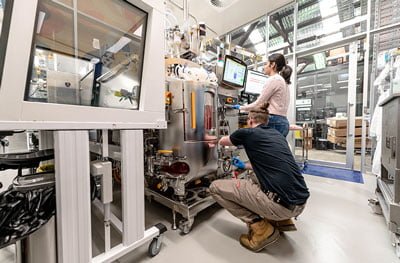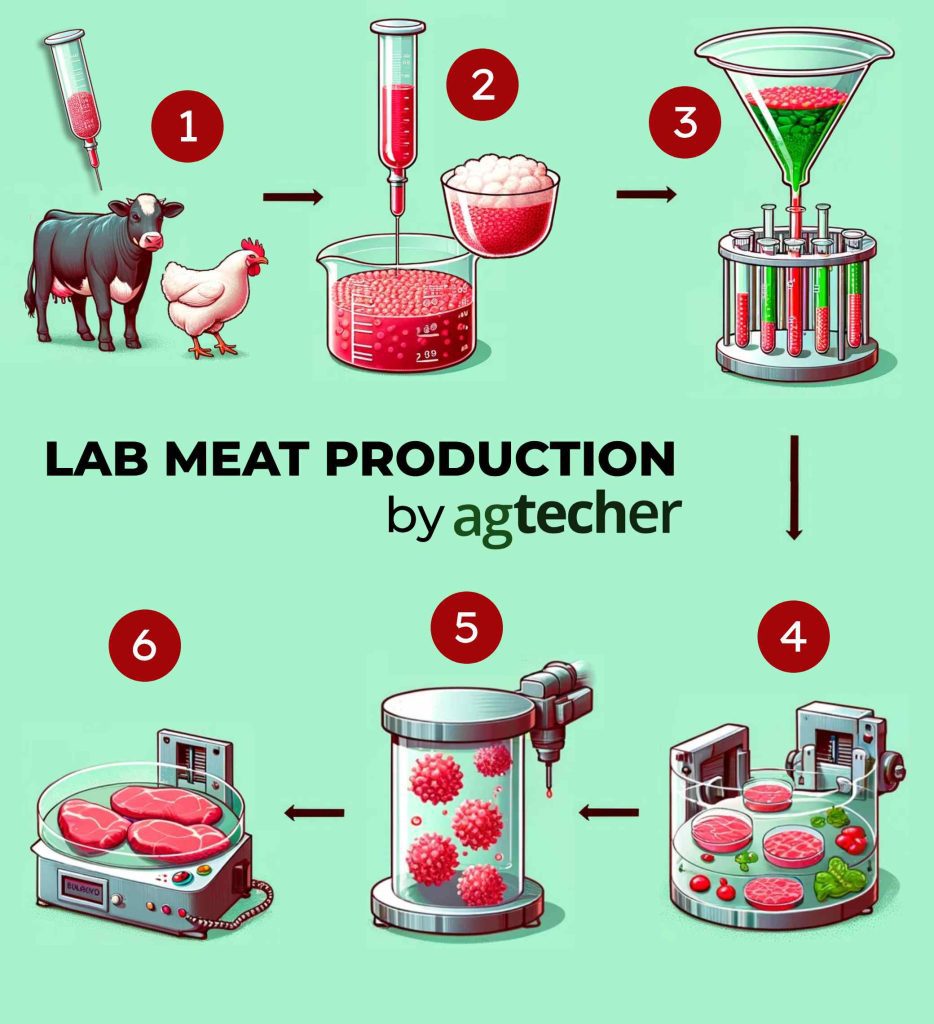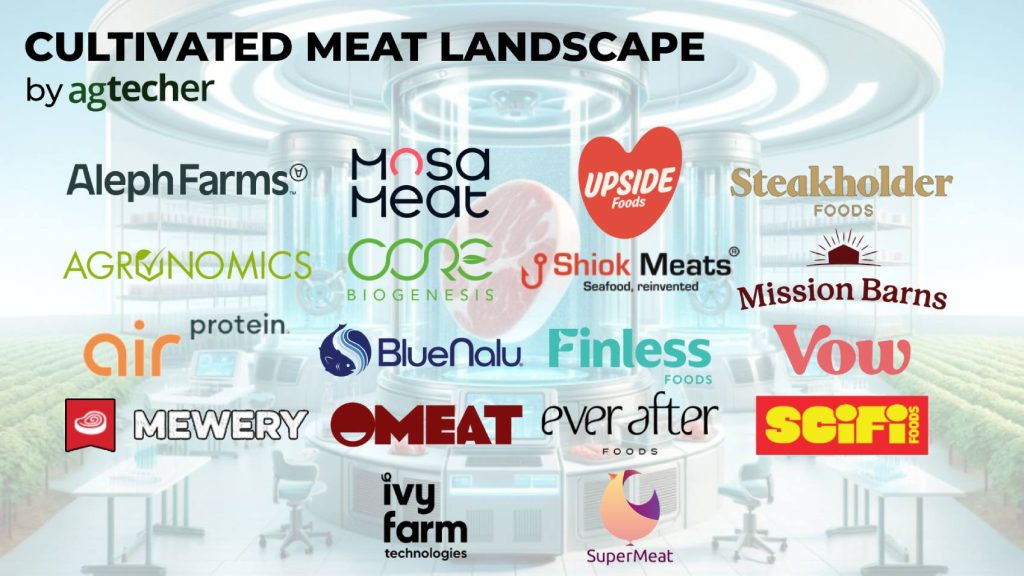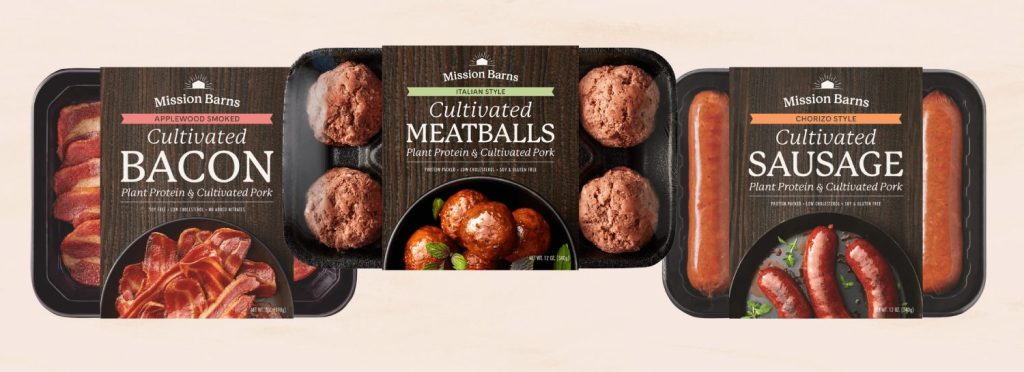As a former hunter and meat-eater, raised in a farming family, my intrigue about plant-based and especially lab-based meat is growing, leading me to explore its production, implications, and potential impact on agriculture and animal welfare.
Cultivated meat, also known as cultured meat or lab meat, is emerging as a transformative solution in the realm of food technology. At its core, cultivated meat is genuine animal meat produced by cultivating animal cells directly, offering a radical departure from traditional animal farming. Lab-based meat eliminates the need to raise and farm animals for food, presenting significant ethical, environmental, and health advantages.
Lab meat could cut down greenhouse gas emissions by up to 92% and land use by up to 90% compared to traditional beef production. Notably, the production process is expected to be entirely antibiotic-free, potentially reducing foodborne illnesses due to lower exposure risks from pathogens. As of late 2022, the cultivated meat sector has expanded to more than 150 companies worldwide, propelled by a staggering $2.6 billion in investments.
With an estimated market share capture from the $1.7 trillion conventional meat and seafood industry, cultivated meat stands as a beacon of hope in addressing critical global challenges. These include deforestation, biodiversity loss, antibiotic resistance, zoonotic disease outbreaks, and the ethical concerns of industrialized animal slaughter.
Overview of this article
1. The author’s journey: From Hunter to Veggie
2. What is Cultivated Meat?
– History of Lab Meat
– The Technological Production Process of Cultivated Meat
3. Leading Innovators in Cultivated Meat
4. Animal Welfare and Ethical Implications
5. Health and Nutrition: Cultivated Meat vs. Plant-Based Meat vs. Traditional Meat
6. Environmental Impact and Sustainability
7. The Lab-Meat Market and Consumer Dynamics
8. Regulatory Landscape and Food Safety
9. Challenges and Future Prospects
– Transformative Effects to Animal Agriculture
1. Introduction: From Hunter to Veggie back to meat?
Growing up in a family deeply rooted in farming and hunting, my childhood memories are vivid with scenes of nature and wildlife. One such memory that stands out is of being four years old, witnessing a huge wild boar, suspended in our garage, as blood slowly drained into the soil beneath. This image, though stark, was a normal part of my upbringing. Hunting and consuming the meat we sourced was a way of life, and by 18, I too had taken up hunting, fully immersing myself in this traditional lifestyle.

cultivated “Chicken chunks” by lab meat company Air Protein
However, at the age of 36, a shift occurred. My decision to stop eating meat was influenced by a multitude of factors. A notable turning point was tasting the Beyond Meat burger, which opened my eyes to the possibilities of plant-based alternatives. Remarkably, this plant-based patty managed to capture the essence of meat so well that it became, for me, the gold standard in meat alternatives.
Recently, my curiosity was piqued by something even more innovative and potentially game-changing: lab-based, or cultivated, meat. This concept was entirely foreign to me, and I found myself intrigued. What is cultivated meat? How is it produced? What are the moral and health implications? And, importantly, what could be its impact on agriculture, the global environment, and animal welfare?
Driven by these questions, I embarked on a deep dive into the world of cultivated meat. This blog post is the beginning of that exploration.
In this article, we will explore the intricacies of cultivated meat, its production process, and its potential impact on the food industry and beyond. We will delve into the challenges faced by the industry, the benefits of this revolutionary approach, and the future prospects as this sector moves towards commercialization.
2. What is Cultivated Meat?
Cultivated meat, also known as lab-based meat, is real animal meat produced through the cultivation of animal cells in a controlled environment. It is a type of cellular agriculture, where the cells are grown in bioreactors, simulating the conditions inside an animal’s body. This method eliminates the need for traditional livestock farming and slaughtering, potentially offering a more ethical, sustainable, and health-conscious approach to meat production.
But let’s start at the beginning, surprisingly enough with a quote from Winston Churchill from the early 20th century.
The history of cultured meat
The history of cultivated meat has deep roots and has involved numerous key figures and milestones:
- Winston Churchill’s Vision: In a 1931 essay, Winston Churchill imagined a future where “we shall escape the absurdity of growing a whole chicken to eat the breast or wing, by growing these parts separately under a suitable medium.”
- Willem van Eelen: Considered a pioneer, Dutch researcher Willem van Eelen conceptualized cultured meat and filed a patent in the 1990s. His passion for food security and production stemmed from his experiences during World War II.
- Early Experiments: The first in vitro cultivation of muscle fibers was performed in 1971 by pathologist Russel Ross. Later, in 1991, Jon F. Vein secured a patent for the production of tissue-engineered meat.
- NASA’s Involvement: NASA conducted experiments in early 2000s, trying to cultivate meat for astronauts, leading to the production of goldfish and turkey tissues.

Mark Post presents the first cultivated meat burger in 2013 (copyright via Mosa)
- New Harvest: Founded by Jason Matheny in 2004, New Harvest became the first nonprofit research institute to support cultivated meat research.
- Public Debut: Mark Post, a Dutch scientist, presented the first cultivated meat burger in 2013, which cost a significant sum and highlighted the challenge of cost reduction in the industry.
- Industry Growth: Since Mark Post’s public demonstration, over 150 companies have emerged globally, with significant investments fueling research and development in the field.
- Singapore’s Approval: In 2020, Singapore became the first country to approve the sale of cultivated meat.
The Technological Production Process of Cultivated Meat
The production of cultivated meat begins with the collection of stem cells from an animal. These cells are then nurtured in bioreactors at high densities, simulating the natural growth environment found within an animal’s body. They are provided with an oxygen-rich cell culture medium, comprising essential nutrients such as amino acids, glucose, vitamins, and inorganic salts, along with growth factors and proteins. Adjustments in the medium composition, often coupled with scaffolding structures, guide immature cells to differentiate into skeletal muscle, fat, and connective tissues – the primary components of meat. This entire process, from cell cultivation to harvesting, is anticipated to take between 2 to 8 weeks, depending on the type of meat being produced.



Production facility at VOW Australia
The detailed production process
1. Cell Selection and Isolation: The journey of cultivated meat starts with selecting the right cells. Typically, myosatellite cells, which are a type of stem cell found in muscle tissues, are isolated because of their capacity to grow and differentiate into the muscle cells that make up the meat. These cells are obtained via a biopsy from a living animal, which is a minimally invasive procedure, or from a cell bank where they can be stored for extended periods.
2. Cell Proliferation: Once isolated, the cells are placed in a nutrient-rich culture medium that supports their growth. This medium contains a blend of amino acids, sugars, trace elements, and vitamins necessary for cell survival and proliferation. Growth factors, which are proteins that stimulate cell division and growth, are also added to encourage the cells to multiply. This is a critical phase where the initial few cells proliferate to become many millions, creating a mass of tissue that will eventually be harvested as meat.

3. Differentiation and Maturation: The proliferated cells must differentiate into the specific types of cells that make up meat, primarily muscle and fat cells. This is achieved by changing the conditions within the bioreactor, such as adjusting the levels of growth factors and other compounds in the culture medium. Scaffolding materials, which can be edible or biodegradable, are introduced to provide a structure for the cells to attach to and mature. This is akin to training the cells to form the textures and structures found in a specific cut of meat.
4. Assembly and Harvesting: Once the cells have matured into muscle fibers and fat tissue, they are assembled to mimic the complex structure of meat. This can involve layering different cell types and integrating them to form a product that resembles the look and feel of a particular meat type, such as steak or chicken breast. The final product is then harvested from the bioreactor, often followed by a phase of post-harvest conditioning where the meat may be aged or seasoned to enhance flavor and texture.
5. Scaling and Production Efficiency: Scaling the production to commercial levels involves optimizing each stage for efficiency and cost-effectiveness. This includes automating the bioreactor operations, improving the culture mediums to reduce reliance on expensive growth factors, and developing scaffolds that are easy to produce and handle. Companies are also exploring ways to recycle the culture medium and capture any emissions from the process to minimize environmental impact.
6. Processing and Refining & Final Product: The muscle fibers, now supported by scaffolds, are processed to enhance their texture and flavor. This can involve additional steps like seasoning, maturing, or marinating, depending on the desired end product. After the muscle fibers have developed the necessary texture and flavor, the cultivated meat is ready to be harvested. The final product is a form of meat that is biologically identical to its traditionally farmed counterpart but created in a more ethical and sustainable way.

Cultivated ribeye steak prototype by Aleph Farms
Here are some more interesting companies in the sector:
3. Innovators & Companies in the lab meat space
The cultivated meat industry, while still in its nascent stages, has witnessed the rise of pioneering companies across the globe. Among the frontrunners is a company from Israel: Aleph Farms. Known for its groundbreaking work in growing steak directly from non-GMO cells. This company, along with others in the field, is not just creating a new product but is in the process of defining a whole new industry.
Fun fact: Leonardo DiCaprio has invested in the cultivated meat companies Mosa Meat and Aleph Farms. He joined these companies as an investor and advisor, highlighting his commitment to environmental activism and sustainable food production

In North America and the European Union, several startups and established companies are taking unique approaches to cultivated meat. UPSIDE Foods: This US has made significant strides in the production of cultivated chicken, having completed a pre-market consultation with the FDA. Similarly a company from the Netherlands has been a notable player: Mosa Meat. Especially for their advancements in reducing medium costs, a critical factor in the scalability and affordability of cultivated meat.

Mission Barns product range presentation of cultivated meat
Here’s a list of innovative companies in the market:
- Steakholder Foods (formerly MeaTech 3D Ltd).: Planning to set up four to five global factories by 2025 with an annual output of 560 tons, MeaTech 3D Ltd. is expanding collaboration with Dutch mycoprotein startup ENOUGH to integrate chicken biomass into their plant-based matrix.
- Agronomics Limited: A venture capital firm focusing on cellular agriculture, with significant investment in SuperMeat The Essence of Meat Ltd, which has developed Kosher-certified chicken cell lines.
- Core Biogenesis: This plant-based bioproduction company has secured $10.5 million in funding to build a facility in France, focusing on growth factors and cytokines for cell therapy and cellular agriculture.
- Shiok Meats: A Singapore-based company, Shiok Meats has launched cell-based shrimp meat and is developing cultivated beef products in collaboration with Mirai Foods.
- Mission Barns: A California-based company specializing in lab-grown meat, Mission Barns has partnered with global meat and alternative protein leaders to expand pilot production facilities.
- Air Protein: Utilizing microbes to turn recycled CO2 into meat alternatives, Air Protein focuses on sustainability and has partnered with ADM for new protein development.
- Blue Nalu: This cell-based seafood startup is focusing on species that are overfished or contain high levels of pollutants, aiming to release products into a test market soon.
- Finless Foods: Specializing in cultured bluefin tuna, Finless Foods aims to develop more sustainable seafood alternatives.
- Vow: An Australian company, Vow is developing cultured alternatives for unique and exotic varieties of meat, including kangaroo and alpaca. The consumer brand is called “Forged”.
- Mewery: The first European cell-based food tech startup focusing on fortified cultivated pork based on microalgae.
- Omeat: Founded by Dr. Ali Khademhosseini, Omeat uses a regenerative technique harnessing cow plasma to produce affordable cultivated meat.
- Ever After Foods: An Israeli company, Ever After Foods (formerly Plurinova) is redefining scalability with their patented bioreactor technology.
- SCiFi Foods: Focused on cultivating real meat from cells, SCiFi Foods aims to create sustainable meat options
- Ivy Farm Technologies: This UK-based company is creating real meat with a focus on environmental sustainability and has recently opened a new R&D facility and pilot plant in Oxford.
- SuperMeat: Focusing on lab-grown chicken, SuperMeat aims to produce clean meat requiring significantly fewer resources.




Cultivated Meat & Seafood: Blue Nalu Bluefin tuna, cultivated Burger meat by Mosa Meat, Super Meat, Finless
4. Animal Welfare
The advent of cultivated meat promises to revolutionize meat production and address profound ethical issues intrinsic to conventional animal agriculture. Industrialized factory farming is increasingly facing criticism for promoting intensive practices without regard for animal welfare, suffering, and broader environmental impacts. Billions of livestock animals worldwide face living conditions, transport, handling and slaughter practices that would shock the conscience of any caring, compassionate human.
Cultivated meat offers an alternative paradigm – producing meat directly from animal cells without the need to breed and raise whole animals, allowing us to meet dietary preferences for meat while potentially eliminating animal suffering on farms. This aligns with ethical arguments to reduce harm, emphasize compassion towards sentient creatures, and steward environmental resources for future generations. As the cultivated meat industry matures, it faces the challenge of replacing fetal bovine serum with completely animal-free growth mediums to truly realize its full ethical potential without hypocrisy.

However, some virtue ethics philosophies caution that cultured meat may not fully replace the need for sustainable animal agriculture with high welfare standards. A balanced dietary shift towards more plant-based options, moderation of meat consumption, and ethical animal farming may still be needed for a compassionate and responsible food system. As innovations continue, transparency, oversight and public discourse will be vital to navigate the nuances around using animal cells while upholding promises to improve animal welfare.
Ultimately, the promise of cultivated meat represents a seismic shift to alleviate animal suffering on an unprecedented scale. But any technological advance is only as ethical as those wielding it – conscientiousness, compassion and balance will be needed to steer biotechnology towards the common good. The path forward will require open minds, soft hearts and an evolving social contract between humans, animals and the planet we share.
5. Health and Nutrition: Nutritional Profile Comparison of Traditional vs. Plant-Based vs. Cultivated
There is an emerging debate contrasting the nutritional merits of traditional animal-based meat, plant-based meat alternatives, and the nascent field of cell-cultured (cultivated) meat. As innovations continue, cultivated meat shows particular promise in overcoming the limitations of existing options by allowing for enhanced nutritional profiles to be engineered directly into lab-grown meat products.
The table below provides a detailed nutritional comparison across the main categories between 100g servings of traditional meat (represented by grass-fed beef), two leading plant-based meat brands (Beyond Meat and Impossible Foods), and current estimates for cultivated meat based on ongoing research:
| Nutrient | Traditional Meat (Beef) | Plant-Based Meat | Cultivated Meat (estimated/engineered) |
|---|---|---|---|
| Calories | 250kcal | 220-290kcal | Optimized for nutrition goals |
| Protein | 24g | 9-20g | 26-28g (higher than traditional) |
| Total Fat | 14g | 10-19.5g | Less saturated fat than traditional |
| Saturated Fat | 5g | 0.5-8g | <1g (drastically reduced) |
| Carbohydrates | 0g | 5-15g | 0g |
| Cholesterol | 80mg | 0mg | 0mg (completely eliminated) |
| Sodium | 75-100mg | 320-450mg | Optimized (lower than plant-based) |
| Antioxidants | None | None | Added through genetic engineering |
| Vitamin B12 | 2.4μg | May be added | Added to match or exceed traditional |
| Iron | 2.5mg | May be added | Added to match or exceed traditional |
| Zinc | 4.2mg | None | Matched to traditional |
| Unique Nutrients | Allantoin, Anserine, DHA and EPA, Carnosine | Fiber, Phytosterols | Optimized fatty acid profile, added vitamins, minerals, antioxidants |
Please note: Nutritional profile of cultivated meat is estimated based on current research and will continue to be optimized as technology and genetic engineering techniques advance. Complete elimination of cholesterol and customization of micronutrients represent current capabilities not possible in other meat alternatives.
As shown, while plant-based products aim to mimic the protein content, amino acid profile, and sensory experience of traditional meat, there are still noticeable differences in essential categories like proteins, fats, sodium, cholesterol and presence of unique nutrients. Moreover, current plant-based meat alternatives rely heavily on additives, flavorings and sodium to match the taste of traditional meat, which can negatively impact their overall health profile.
In contrast, cultivated meat represents a true animal-based meat produced directly from animal cells without the need to raise and slaughter entire animals. This allows for full control over the phenotypic expression of nutrients, vitamins, minerals, functional compounds like polyunsaturated fatty acids, and even entirely novel nutrients not found in traditional meat through genetic engineering techniques. Scientists have already demonstrated some early successes, such as producing cultivated beef embedded with high levels of plant-based nutrients like beta-carotene.

Aleph Cuts product presentation of cultivated meat, cooked
As the technology matures, cultivated meat is poised to offer superior nutritional customization potential compared to existing meat alternatives on the market.
Health & Safety Implications: Beyond nutritional profiles, there are wider public health implications of shifting meat production from conventional animal agriculture to cultivated methods:
Food Safety & Pathogens: Cultivated meat’s controlled and sterile production environment eliminates the risk of bacterial, viral and prion contamination prevalent with slaughtered livestock. Common deadly outbreaks in meat processing plants would be reduced for safer end products.
Disease & Antibiotic Resistance: Traditional factory farm conditions are breeding grounds for zoonotic infectious diseases and antibiotic-resistant superbugs due to rampant antibiotic overuse. Cultivated meat production avoids this risk while meeting global protein demand more sustainably.
Accessibility & Affordability: If production costs of cultivated meat fall below traditional farming as expected, increased accessibility and affordability of meat could help alleviate malnutrition for vulnerable groups globally.
The unique control over the tissue engineering process also allows cultivated meat to surpass plant-based meat alternatives and offer superior nutritional customization and food safety profiles. As innovations continue, cultivated meat shows significant promise as the healthier and more ethical future of meat production compared to alternatives available today.
6. The Sustainability Case for Cultivated Meat
As the cultivated meat industry progresses, understanding its sustainability profile compared to alternatives is critically important for global food systems facing intensifying resource constraints. An in-depth life cycle assessment from Aleph Farms highlights the immense efficiency potential of lab-grown meat manufactured directly from animal cells. Their analysis reports transformative reductions if produced at scale with renewable energy:
- 90% less land usage
- 92% lower greenhouse gas emissions
- 94% reduced pollution
- 5-36X increased feed conversion efficiency
Such dramatic gains speak to cultivated meat’s prospect in alleviating the heavy environmental burden of industrial beef production, which accounts for nearly two-thirds of the total climate impact from livestock globally. Shifting even a small proportion of conventional meat production to more sustainable cultivated methods could deliver outsized decarbonization and resource conservation benefits.

Moreover, cultivated meat also promises a 7-10 fold improvement in calorie conversion efficiency compared to traditional beef production. Conventional meat’s metabolic inefficiency squanders over 90% of feed calories during digestion and basic organismal function rather than depositing it as edible meat. In contrast, cultured meat directly converts tailored growth nutrients like sugars and amino acids into muscle tissue with much higher efficiency in a bioreactor.
This combined value proposition – sharply decreasing land, water and emissions footprints while significantly improving calorie conversion – paints a compelling sustainability profile for scaled cultivated meat outpacing conventional livestock agriculture.
Sustainability Comparison Table The table below provides a detailed sustainability comparison between major meat production approaches:
| Sustainability Factor | Cultivated Meat | Plant-Based Meat | Grain-Fed Beef | Grass-Fed Beef |
|---|---|---|---|---|
| Land Use Reduction | 90% | Highly variable, crop dependent | None | Lower than grain-fed |
| Greenhouse Gas Emissions Reduction | 92% | Up to 90% | High emissions | Lower than grain-fed |
| Pollution Reduction | 94% | Lower than beef | Manure runoff, fertilizers | Lower due to fewer inputs |
| Feed Conversion Efficiency | 5-36X more efficient | More efficient | Inefficient | More efficient than grain-fed |
| Water Use Reduction | High | Highly variable | High | Lower than grain-fed |
| Energy Use | Lower with renewable energy | Lower than beef | Intensive feed production | Lower fossil fuel reliance |
| Biodiversity Impact | Positive due to reduced grazing land | Potentially positive | Negative, habitat destruction | Negative, habitat degradation |
| Climate Change Burden | Much lower | Significantly lower | Very high | High methane emissions |
The key highlights from the table:
- Cultivated meat exceeds conventional beef along all major sustainability dimensions when powered by renewable energy
- Plant-based meat remains extremely efficient for land and water use with lower impact crop proteins
- Beef production has very high resource demands, emissions and biodiversity destruction
The side-by-side analysis shows cultivated meat exceeding both plant-based and traditional beef across the sustainability indicators. By recapitulating meat directly from animal cells without intermediate livestock, cultivated products promise transformative efficiency gains in natural resource usage and pollution footprint.
However, impacts depend partly on specific production methods. Utilizing renewable energy and bio-based nutrients would further improve sustainability, while use of fetal bovine serum involves tradeoffs. Plant-based alternatives also remain extremely water and land use efficient with less resource-intensive proteins.
Reshaping the Global Food Landscape with Cultivated Meat
The push towards cultivated meat is not only a response to the ethical and environmental concerns associated with traditional meat production but also a potential answer to the looming food security challenges posed by a growing global population. According to research by Tuomisto and Teixeira de Mattos, the environmental impacts of cultured meat production are promising, particularly if renewable energy sources are utilized. Their study estimates that cultured meat could require up to 45% less energy, 99% less land, and produce 96% fewer greenhouse gas emissions than conventional beef production, provided that energy-efficient production systems are employed (Environmental Science & Technology, 2011).
In a comprehensive life cycle analysis, Smetana et al. assessed various meat substitutes and found that cultivated meat alternatives show a clear advantage in terms of potential environmental impact when compared to conventional meat (International Journal of Life Cycle Assessment, 2015). The study emphasized that the environmental benefits of cultivated meat production become more pronounced as the industry scales and technologies improve.
Furthermore, a study by Mattick et al. points out that while the agricultural and land inputs for cell-based meat could be lower than those for animal-based meat, the energy requirements may be higher since biological functions are replaced by industrial processes (Environmental Science & Technology, 2015). This underscores the need for continuous improvement in bioprocessing efficiency and the integration of sustainable energy sources to ensure the long-term viability and environmental benefits of cultivated meat.
As the cultivated meat industry matures, it has the potential to drastically reduce the global agricultural land use. Alexander et al. posed that the adoption of alternative protein sources, including insects, cultured meat, and imitation meat, could lead to a significant decrease in global agricultural land requirements (Global Food Security, 2017).
In totality, cultivated meat represents the most sustainable way yet to produce authentic animal meat, but all alternatives have an important role in transitioning the food system onto a more renewable path.
7. The Lab-Meat Market & Consumer Dynamics
According to The Good Food Institute and other evaluators, the alternative protein sector, including cultivated meat, is gaining traction not just as a niche market but as a mainstream food source. Their reports highlight the increasing number of conferences, media articles, and meetings with decision-makers in the food industry, signifying a growing interest and acceptance of cultivated meat products.
The cultivated meat industry is rapidly gaining traction. In 2022, the global market size was valued at USD 373.1 million and is forecast to grow to an impressive USD 6.9 billion by 2030, at a CAGR of 51.6% from 2023 to 2030. This expansion is partly fueled by the increasing consumer preference for sustainable and ethical meat alternatives, with products like burgers leading the market with a share of around 41% in 2022.
$373 MILLION
—CULTIVATED MEAT market SIZE IN 2022
$6.9 billion
—MARKET FORECAST by 2030
$1700 billion
—MEAT & SEAFOOD market 2022
The market is also seeing substantial investment and innovation. For instance, Mosa Meat and Nutreco’s ‘Feed for Meat’ project was awarded a grant of almost USD 2.17 million to advance cellular agriculture and bring cultivated beef to the EU market. North America, dominating with a share of over 35% in 2022, is seeing increased demand for sustainable meat and poultry products, with companies like Fork & Goode and BlueNalu making significant investments.
The Asia Pacific region is expected to witness the fastest growth, with a CAGR of 52.9% from 2023 to 2030. This growth is driven by rising disposable incomes and investments in lab-grown seafood, supported by favorable government initiatives in countries such as Singapore and China.
However, there are hurdles to overcome. Cultivated meats initially bear a premium price, potentially putting them out of reach for some consumers, although prices are expected to fall as the industry scales. McKinsey suggests that within a decade, cultivated meat production costs could reduce by 99.5%, dropping from the low thousands of dollars to under $5 per pound.
2023 Sees Downturn in Funding
There is significant downturn in funding for cultivated meat companies in 2023. This year witnessed a dramatic 78% decline in investment, plummeting to $177 million from the previous year’s $807 million, amidst a broader 50% drop in agrifoodtech investing. This sharp decline reflects a general risk aversion among investors, significantly impacting companies within the cultivated meat and seafood sectors. High-profile examples of the challenges faced include Finless Foods’ rumored cutbacks, the closure of New Age Eats, and legal troubles for GOOD Meat with its bioreactor supplier over alleged unpaid bills.
Despite these hurdles, certain startups like Uncommon in the UK and Meatable in the Netherlands have managed to secure significant funding, illustrating that while the market has contracted, there remains investor interest in promising technologies within the sector. Moreover, the investment landscape is expected to see some recovery as venture capitalists who have raised record amounts for new funds begin to deploy capital, with sovereign wealth funds and large meat companies playing pivotal roles in the sector’s future.
The market’s overall decline is part of a wider trend in foodtech investment, which has seen a significant downturn across various segments, including eGrocery and innovative food, which encompasses alternative proteins. This context sets a challenging but evolving landscape for cultivated meat companies, with potential for recovery and growth as the market adjusts and new investment strategies emerge. Source.
8. Navigating the Regulatory Landscape
As cultivated meat innovations accelerate, regulatory agencies across the globe are determining how these novel products fit into existing food and safety frameworks. This emerging sector requires updated regulations to ensure cell-cultured foods meet stringent safety, labeling, and quality standards before reaching consumer markets.
In the United States, the FDA and USDA have jointly developed an overarching structure for how cultivated meat will be regulated. This aims to guarantee safety while engendering public trust in cultivated products, holding them to identical high benchmarks as traditional meat. The FDA oversees cell collection and growth, reviewing production methods and materials for food safety. The USDA regulates harvest and labeling, certifying facilities and enforcing standards for interstate commerce.
The recent FDA approval of cultivated chicken represented the world’s first regulatory green light for cultured meat. This precedent sets up other promising products in the pipeline pending USDA labeling authorization before full commercial launch.
Globally, regulation varies across different countries and their trade blocs. The European Union regulatory processes emphasize stringent safety assessments, with the European Food Safety Authority playing a central role evaluating novel production methods. However, some European nations like Italy and France have proposed outright bans on cultivated meat, citing cultural or health concerns.

Aleph Cuts cultivated meat product shot
The Asia-Pacific region provides a mosaic of regulatory perspectives on cultivated meat moving towards commercial reality. Pragmatic regulatory plans are underway in Israel, UK, Australia and New Zealand leveraging existing novel food frameworks, while China has prioritized funding and development recognizing future potential. In contrast, Japan is taking a more cautious approach assembling expert teams to establish safety regulations before market entry.
Overcoming Regulatory Barriers The regulatory environment for bringing cultivated meat to market remains complex and fluid across jurisdictions. However, pragmatic regulatory frameworks are emerging to evaluate these innovative products, balancing safety with support for technological advancement in more progressive countries.
Open communication and transparent data will be instrumental in achieving regulatory milestones on the path to public acceptance. Successfully navigating regulatory pathways also promises to unlock enormous social benefits from this technology – potentially alleviating ethical concerns, enhancing food security, reducing environmental damage, and allowing for a more compassionate and sustainable future food system.
Economic Implications and Industry Scalability
The economic impact of the cultivated meat industry is poised to be substantial. As production costs decline and scalability increases, the market is expected to reach an inflection point that will allow for mass adoption. The transition from niche to mainstream will have significant implications for the global meat industry, potentially disrupting the existing supply chain while creating new opportunities for innovation and employment.
The scalability of cultivated meat production is crucial. Current industry efforts are geared towards reducing the cost of growth mediums and improving bioreactor designs to facilitate large-scale production. As these technological hurdles are overcome, we can anticipate a significant reduction in the price of cultivated meat, making it competitive with, and eventually cheaper than, conventional meat.
9. The Future of Meat: Prospects and Challenges
As we look towards a future where cultivated meat may play a central role in our food systems, it’s important to assess the trajectory of this industry. A paper published in Nature’s Scientific Reports suggests that cultivated meat has the potential to substantially mitigate the environmental impact of meat production, with reductions in land use, greenhouse gas emissions, and pollution.
Leading companies in the space like Aleph Farms and Upside Foods have already made significant strides in improving the scalability and sustainability of cultivated meat. As these companies work towards commercialization, the market potential appears promising. Studies suggest that by 2030, the cultivated meat industry could claim a significant share of the global meat market, potentially reaching a valuation of several billion dollars.

Identifying Ongoing Challenges and Potential Breakthroughs
Despite the optimistic outlook, there are several challenges that the industry must overcome. Scaling up production to meet global demand while maintaining quality and reducing costs remains a key hurdle. The cost of cell culture media and the need for bioreactors capable of mass production are areas requiring innovation and investment.
Consumer acceptance is another challenge. While there is a growing interest in alternative proteins, cultivated meat must overcome perceived naturalness concerns and meet consumer expectations for taste and texture. Moreover, regulatory approval processes vary by region, posing additional complexities for global distribution.
Potential breakthroughs in biotechnology, such as the development of serum-free media and advancements in scaffold technology, could propel the industry forward. Collaborations between startups and established food companies could also accelerate progress by combining innovative techniques with scaling expertise.
Cutting-edge innovation may slash cultivated meat production cost
As curiosity about cultivated meat grows, it is important to explore the key innovations propelling this industry forward. In particular, a recent development caught attention – scientists have created a method to dramatically reduce the production costs of cultivated meat.
Researchers at Tufts University have genetically engineered bovine muscle cells to produce their own growth factors. These growth factors are signaling proteins that trigger cells to proliferate and differentiate into skeletal muscle tissues. Previously, growth factors had to be continually added into the cell culture medium, accounting for up to 90% of production costs.

Cultivated Scallop by Air Protein
By modifying stem cells to generate their own growth factors, the Tufts team has significantly cut the costs associated with cell culture media. Although the self-producing cells grew slower, the scientists believe further optimization of gene expression levels can improve muscle cell growth rates.
Innovations like this are vital to making cultivated meat price-competitive with conventional meat. As production technologies and bioprocesses continue to advance, the dream of affordable, sustainable cultivated meat coming to grocery store shelves seems increasingly within reach.
Transformative Effects to Animal Agriculture
Now, what will all this mean for traditional animal farming?
The rise of cultivated meat could bring bring transformative changes to the agricultural sector, impacting conventional meat production and supply chains. This innovation could significantly disrupt current agricultural practices, particularly livestock farming, and alter food production methodologies. Cultivated meat reduces the need for large-scale animal husbandry, leading to potential shifts in focus and practices in traditional agriculture. Of course, the lab-meat industry faces the challenge of high production costs and technological hurdles to make cultured meat a viable and affordable alternative.
Economic Impact and Opportunities:
- Farmers may face economic instability as demand for farm-raised meat declines, affecting connected industries like feed production, transportation, and slaughterhouses.
- However, this could increase the value of natural meat, potentially turning it into a luxury item and fetching higher prices for small-scale farmers focusing on quality.
- Reduction in farming costs is likely as cultured meat requires fewer resources, allowing farmers to maintain smaller herds with lower costs.
- Farmers and the agriculture sector might find new opportunities to innovate and diversify, such as participating in the cell-culturing process or supplying plant-based inputs for cell growth mediums.
Environmental and Ethical Considerations:
- Cultivated meat offers environmental advantages like lower greenhouse gas emissions, reduced land use, and potentially less use of fertilizers and water for feed crops.
- It also addresses ethical concerns related to animal welfare in traditional farming.
- The shift towards sustainable and high-value agricultural practices could emphasize quality over quantity, promoting more natural and humane farming methods.
Supply Chain and Market Dynamics:
- The supply chain will shift from a complex system of livestock management to a more streamlined, lab-based production, potentially becoming more localized.
- Cultivated meat companies must navigate regulatory landscapes and engage in responsible marketing to gain consumer trust.
- Traditional meat industry incumbents may push back to protect their market share.
And with that, I conclude and close out my deep dive into this large, meaty topic.

















